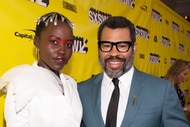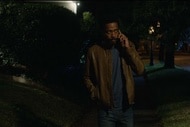Create a free profile to get unlimited access to exclusive videos, sweepstakes, and more!
The Blacklist: How classic radio and Batman influenced Season 7's stylish comic book finale

There's no doubt that film and television productions are struggling in the age of coronavirus. While some projects remain on indefinite hold, others have been forced to adapt with the times. In the case of TV, truncated seasons are becoming the norm for shows like The Flash and The Blacklist, which couldn't finish their intended episode shoots before the pandemic hit.
Finding the right way to end a season prematurely isn't easy, but NBC's The Blacklist decided to make the best of the situation by concluding Season 7 (it's ending after 19 episodes instead of the planned 22) with a balls-to-the-wall hybrid of live-action and comic book-inspired animation that recalls Richard Linklater's A Scanner Darkly.
"I think one of the things that pushed us in this direction is the inherent comic book nature of The Blacklist," executive producer Jon Bokenkamp exclusively tells SYFY WIRE. "We often talk about how our show is bigger than life, and living in a slightly alternate universe. Every week Red" — played by Age of Ultron's James Spader — "introduces us to a new, strange bad guy that the FBI doesn’t know about, sort of a rogues' gallery of criminals. I think that element of the show made the hybrid of a live action-animated concept feel rather organic in a way that it might not on other shows."
Filming on Episode 19 ("The Kazanjian Brothers") — which finds The Task Force looking into "an accountant who works for lucrative criminals in order to find the violent and thuggish brothers hired for his protection," according to an official synopsis — was halfway done when the health crisis reared its ugly head.
"Jon and I started talking about how we might be able to finish it," says fellow EP John Eisendrath. "Our first idea was radio theater. For scenes that hadn’t been filmed, we’d put a still image of an old-fashioned radio on the TV and have the cast read their dialogue. Our second idea was to have comic book pages drawn for the unfinished scenes and put those still images on screen as the cast read their dialogue. Our third idea was to animate the unfinished scenes."
Deciding to pursue that final idea, the producers got in touch with Proof, Inc., a company that specializes in pre-visualization for feature films. They worked with its animators in London and Atlanta for "five weeks in an often round-the clock work schedule to get it done," Eisendrath adds.
Going the graphic novel route wasn't all that strange for the show, as it had already received a comic book series (written by Nicole Phillips and drawn by Beni Lobel) from Titan back in 2015. Because of that, the producers had an established frame of reference for the finale's visual aesthetic.
"The comics really forced us to step back and look at the show in a new way. We tried to drill down on the aspects of our show that are hopefully somewhat iconic," Bokenkamp continues. "Things like Reddington’s silhouette, the fedora and the jacket, the D.C. skyline. Because we didn’t have the nuances of the actual actors' faces, we were forced to look at each scene and shot like a comic book panel. We tried to find a balance between the Blacklist TV show and a heightened, larger-scale version of that world reimagined as a graphic novel."
"The comics worked well because they reflected the often graphic-novel feel of the show. [A] brutal anti-hero, larger-than-life villains," Eisendrath says. "The comics provided a roadmap to how the series could be animated, and had Jon and I not thought back to them while brainstorming ways to complete this episode, we never would have hit on the idea of animation."
And, of course, looking to a few other comic icons for inspiration didn't hurt, either.
"I have a copy of Frank Miller and David Mazzucchelli’s Batman [Year One] on my bookshelf. During this process, I frequently referred to it in conversations about everything from look and style, to chapter headings and chyrons," Eisendrath reveals.
"One of the things that evolved as the episode took shape was the use of thought bubbles and animated boxes that tell us where we are," Bogenkamp notes. "At one point, I remember we were wondering if the emotion was coming across on screen — if the audience would understand what our character was thinking in a critical scene — and it suddenly occurred to us all, 'Wait! We put those thoughts onto the screen in a text box! That’s what a comic book would do.' That really helped us embrace the animated aspect of this episode."
To naturally blend the live-action and animation without throwing the audience out of the story, the production chose a glitch effect that would connote a convergence of two realities. Again, this little trick was something that already existed in The Blacklist toolshed.
"The glitch transition that we use came from our visual effects house," Bogenkamp concludes. "They took a cue from our title sequence, and used that same glitch effect, jumbling various pieces of the screen, and embraced that concept as the device that would take us between both worlds. I think it is a really smart, organic way to take us in and out of these two worlds."
The finale premieres on NBC tomorrow (Friday, May 15) at 8 p.m. EST. The series was renewed for an eighth season in February of this year.
Check out a few more stills from the episode in the media gallery below....
(SYFY WIRE and NBC are both owned by NBCUniversal.)





























